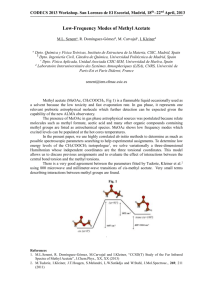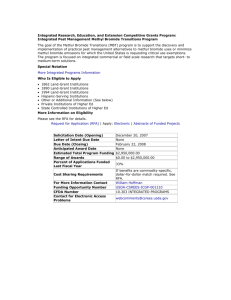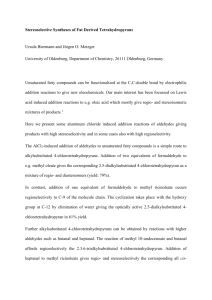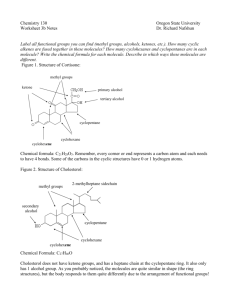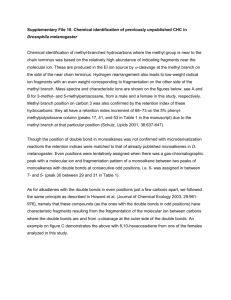GERFBB_edited - Who does peer review?
advertisement
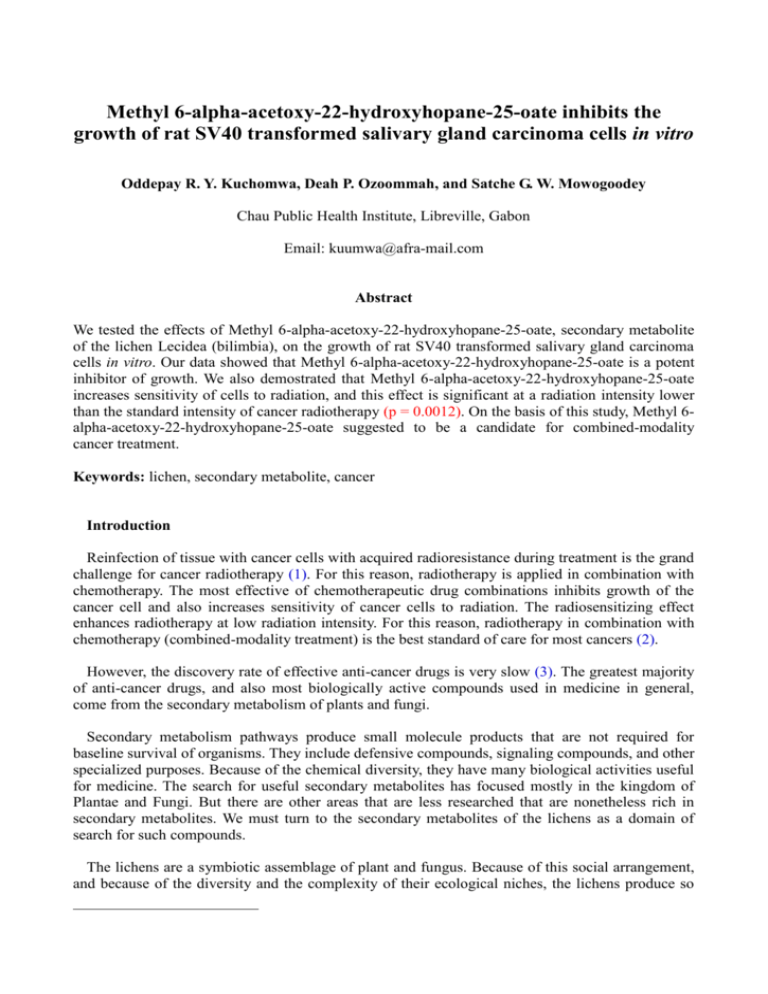
Methyl 6-alpha-acetoxy-22-hydroxyhopane-25-oate inhibits the growth of rat SV40 transformed salivary gland carcinoma cells in vitro Oddepay R. Y. Kuchomwa, Deah P. Ozoommah, and Satche G. W. Mowogoodey Chau Public Health Institute, Libreville, Gabon Email: kuumwa@afra-mail.com Abstract We tested the effects of Methyl 6-alpha-acetoxy-22-hydroxyhopane-25-oate, secondary metabolite of the lichen Lecidea (bilimbia), on the growth of rat SV40 transformed salivary gland carcinoma cells in vitro. Our data showed that Methyl 6-alpha-acetoxy-22-hydroxyhopane-25-oate is a potent inhibitor of growth. We also demostrated that Methyl 6-alpha-acetoxy-22-hydroxyhopane-25-oate increases sensitivity of cells to radiation, and this effect is significant at a radiation intensity lower than the standard intensity of cancer radiotherapy (p = 0.0012). On the basis of this study, Methyl 6alpha-acetoxy-22-hydroxyhopane-25-oate suggested to be a candidate for combined-modality cancer treatment. Keywords: lichen, secondary metabolite, cancer Introduction Reinfection of tissue with cancer cells with acquired radioresistance during treatment is the grand challenge for cancer radiotherapy (1). For this reason, radiotherapy is applied in combination with chemotherapy. The most effective of chemotherapeutic drug combinations inhibits growth of the cancer cell and also increases sensitivity of cancer cells to radiation. The radiosensitizing effect enhances radiotherapy at low radiation intensity. For this reason, radiotherapy in combination with chemotherapy (combined-modality treatment) is the best standard of care for most cancers (2). However, the discovery rate of effective anti-cancer drugs is very slow (3). The greatest majority of anti-cancer drugs, and also most biologically active compounds used in medicine in general, come from the secondary metabolism of plants and fungi. Secondary metabolism pathways produce small molecule products that are not required for baseline survival of organisms. They include defensive compounds, signaling compounds, and other specialized purposes. Because of the chemical diversity, they have many biological activities useful for medicine. The search for useful secondary metabolites has focused mostly in the kingdom of Plantae and Fungi. But there are other areas that are less researched that are nonetheless rich in secondary metabolites. We must turn to the secondary metabolites of the lichens as a domain of search for such compounds. The lichens are a symbiotic assemblage of plant and fungus. Because of this social arrangement, and because of the diversity and the complexity of their ecological niches, the lichens produce so many chemicals for unique colors, signaling between symbionts, manipulation of UV light, and defense against the foragers. Previous studies of lichens have established that the majority of biologically active secondary metabolites are concentrated in a structure of the lichen called the thallus. It is a unique structure composed of fungal hyphae that produces abundant chemicals that interact with the environment of the lichen (Picture 2). Today, more than 700 secondary metabolites of lichens are isolated from the thallus. However, only a small number are characterized for biological activity (4). Part of the problem is the difficulty of extraction. Another problem is the relatively smaller size of the community of scientists who focus on lichens, compared to other organisms. This study explores the biological activity of Methyl 6-alpha-acetoxy-22-hydroxyhopane-25-oate, a secondary metabolite of the lichen Lecidea (bilimbia) (Picture 1). Picture 1. Lecidea (bilimbia) is a common and easily obtained species of lichens that lives worldwide. Picture 2: The thallus of Lecidea (bilimbia). This structure is the source of most secondary metabolites from lichens. Cancer is a complex disease that begins with the uncontrolled growth of the cell. The cancer cell does harm by forming tumors, absorbing tissues, and spreading through the body by metastasis. The highest probability of survival from cancer is with strong inhibition of proliferation of the cancer cells at the beginning of this progression (5). Therefore, the establishment of the inhibition of proliferation of cancer cells in vitro is the critical first step for drug discovery. In our method to determine the biological activity of Methyl 6-alpha- acetoxy-22-hydroxyhopane-25-oate, we test the effect on the growth of rat SV40 transformed salivary gland carcinoma cells in vitro. In addition, we test the effect in combination with irradiation with a range of intensity. Materials and Methods Chemicals: Pure extracts of Methyl 6-alpha-acetoxy-22-hydroxyhopane-25-oate were dissolved and serially diluted in a 2:1 mixture of ethanol and phosphate buffered saline (EtOH / PBS, pH 7.4). These solutions were added as aliquots of 0.01 ml to 0.99 ml of cell culture to achieve the final concentrations of Methyl 6-alpha-acetoxy-22-hydroxyhopane-25-oate: 10 µM, 1 µM, 0.1 µM, 0.01 µM, 0.001 µM, and 0.0001 µM. The control group received 0.01 ml of growth medium. Lichen secondary metabolite extraction. Each thallus of Lecidea (bilimbia) was divided into two pieces. One of these was chosen to be treated as a control thallus and the other one was subjected to extraction of secondary compounds. If the thallus diameter was less than 3 cm, two thalli of same size and shape were used instead. Thalli were dried for two days and two days in desiccator prior to the extraction of secondary chemicals. Following the method of Solhaug and Gauslaa (7), lichens were rinsed four times with dry acetone at room temperature for 5 min. Acetone is not effective to extract many secondary metabolites so we used ethyl acetate for the extraction. Solhaug and Gauslaa have shown that acetone treatment does not affect either long- or short-term viability of dry lichens, and that ethyl acetate has no adverse effects on lichen viability when applied in the same manner. Secondary chemicals from thalli were weighed after 10, 30, 60, and 90-second extraction in ethyl acetate. Solvents evaporated completely from thalli for 24 h on tared dishes before weighing. Cells and cell culture: Rat SV40 transformed salivary gland carcinoma cells were grown in Roswell Park Memorial Institute (RPMI) 1640 medium supplemented with 2 mg/ml N-2-hydroxyethylpiperazine-N'-2ethanesulfonic acid, 100 U/ml penicillin G, 0.1 mg/ml streptomycin, 2 mg/ml sodium bicarbonate, and 5% fetal bovine serum (FBS). Cell cultures were washed with PBS, then treated with 0.2% trypsin/PBS, and then washed with RPMI 1640 medium and centrifuged. The cell pellet was resuspended in RPMI 1640 medium and washed with more medium and the cells were counted. Methyl 6-alpha-acetoxy-22-hydroxyhopane25-oate solutions were aliquoted to cells in 24-well plates. The treated cells were then cultured in 100 mm plastic tissue-culture dishes at 37 oC with 5% CO2 under high humidity. The final cell counts were measured after 5 days growth. Irradiation: Cells were irradiated with a single dose of external radiation from a Cesium-137 source. Doses in the range of 0.5 to 15 Gy were used. The dose rate was 1 Gy per 4 sec. A control group received no radiation. Data analysis: Three independent replicates of the experiment were performed to obtain means and standard deviations. Mean cell counts were normalized to control cells grown in parallel. Significance of differences between treatments was determined by analysis of variance and Student's t-tests using the R statistical package (R Foundation for Statistical Computing, Vienna, Austria). A p-value of <0.01 was accepted as significant. Results and Discussion Lichen secondary metabolite extraction. Lecidea (bilimbia) thalli were divided into 5 groups of 3 thalli each for extraction. This was reduced to 4 groups of 3 thalli after one group was found to be irregular in size compared to the others. Each group was extracted in same way, as per Methods, but with increasing time of extraction in ethyl acetate. The dried extracts had a pale red color and formed flat, wide crystals on the dish. Picture 3 shows the crystals. Picture 3: Dried material after ethyl acetate extraction of Lecidea (bilimbia) thalli. The material formed flat red crystals on the surface of the dish. Figure 1 shows the resulting dry-weights from extraction of thalli. The goal was to extract at least 100 µg for chromatography. Unfortunately, only approximately 1 µg was the weight of the extracts. The method of Solhaug and Gauslaa did not function with Lecidea (bilimbia) thalli. To continue the experiment, we requested a pure extract of Methyl 6-alpha-acetoxy-22-hydroxyhopane-25-oate previously extracted by Dan N. Raboniras. He kindly donated a sample to us. Figure 1: Dry-weight of extracts from Lecidea (bilimbia) thalli after ethyl acetate extraction. Weight in µg are shown against increasing extraction time in seconds. Dose-dependent effect of Methyl 6-alpha-acetoxy-22-hydroxyhopane-25-oate on the growth of rat SV40 transformed salivary gland carcinoma cells. We cultured the cells in parallel with doses of Methyl 6-alpha-acetoxy-22-hydroxyhopane-25-oate at different concentrations. We measured the cell proliferation after 5 days in the logarithmic growth phase. Figure 2 shows the results of the first experiment. All concentrations of Methyl 6-alpha-acetoxy22-hydroxyhopane-25-oate had a similar level of effect. And all concentrations cause a significant inhibition of cell growth compared to the control. Cell growth is inhibited with treatment at the lowest concentration of Methyl 6-alpha-acetoxy-22-hydroxyhopane-25-oate (0.0001 µM), which causes 70% slower proliferation compared to the control (p < 0.001). Figure 2: Dose-dependent effect of Methyl 6-alpha-acetoxy-22-hydroxyhopane-25-oate on the growth of rat SV40 transformed salivary gland carcinoma cells. The X axis is concentration (µM) Methyl 6-alpha-acetoxy-22-hydroxyhopane-25-oate in culture tubes before growth. The Y axis is cell count after 5 days of growth, normalized to cell count of the control. Confidence intervals at 95% are indicated. The difference between 0.0001 µM Methyl 6-alpha-acetoxy-22-hydroxyhopane25-oate treatment and control is significant (p < 0.001). Effect of Methyl 6-alpha-acetoxy-22-hydroxyhopane-25-oate in combination with irradiation on the growth of rat SV40 transformed salivary gland carcinoma cells. With the results of the first experiment, we test the lowest concentration Methyl 6-alpha-acetoxy-22-hydroxyhopane-25-oate (0.0001 µM) in combination with gamma radiation. We grow the cells identically as the first experiment, but with the following modification. Again, pure extracts were dissolved and serially diluted in a 2:1 mixture of ethanol and phosphate buffered saline (EtOH / PBS, pH 7.4). These solutions were added as aliquots of 0.01 ml to 0.99 ml of cell culture to achieve the final concentration of Methyl 6-alpha-acetoxy-22-hydroxyhopane-25oate (0.0001 µM). The control group received 0.01 m/l growth medium and no irradiation. Figure 3 shows the results of the second experiment. Lower than nanomolar concentration of the Methyl 6-alpha-acetoxy-22-hydroxyhopane-25-oate powerfully enhances the inhibition effect of radiation on cell growth. This effect is significant at 0.5 Gy, the lowest level of radiation (p = 0.0012). Figure 3: Effect of Methyl 6-alpha-acetoxy-22-hydroxyhopane-25-oate in combination with irradiation on the growth of rat SV40 transformed salivary gland carcinoma cells. The X axis is intensity (Gy) of radiation. The Y axis is cell count after 5 days of growth, normalized to cell count of the control. Cells were irradiated after treatment with 0.0001 µM Methyl 6-alpha-acetoxy-22hydroxyhopane-25-oate. Confidence intervals at 95% are indicated. The difference between 0.5 Gy and control is significant (p = 0.0012). In this study, we test the biological activity of Methyl 6-alpha-acetoxy-22-hydroxyhopane-25oate, secondary metabolite of the lichen Lecidea (bilimbia). Specifically we measure the effect on growth of rat SV40 transformed salivary gland carcinoma cells in vitro. Our results show that Methyl 6-alpha-acetoxy-22-hydroxyhopane-25-oate inhibits cell growth. The mechanism of action is unknown, but the effect is potent. Even at the lowest dose (0.0001 µM), Methyl 6-alpha-acetoxy-22-hydroxyhopane-25-oate has a significant negative effect on cell growth in vitro after 5 days of logarithmic growth compared to the control. To determine if the inhibition effect interacts with gamma radiation, we test rat SV40 transformed salivary gland carcinoma cells with 0.0001 µM Methyl 6-alpha-acetoxy-22-hydroxyhopane-25-oate and a range of radiation intensity. The result proves that Methyl 6-alpha-acetoxy-22hydroxyhopane-25-oate is also a radiosensitizer. Methyl 6-alpha-acetoxy-22-hydroxyhopane-25oate enhances the inhibition effect of radiation on the growth of cancer. This effect is significant at 0.5 Gy, a radiation dose that is lower than the standard radiation dose in cancer radiotherapy. We propose the biological activity of Methyl 6-alpha-acetoxy-22-hydroxyhopane-25-oate is related to lichen ecology. It is known that lichens are adapted for the manipulation of radiation, and also adapted for defense against the foragers (6-8). Therefore, it is not surprising that the secondary metabolites of the lichen can enhance the effect of radiation and inhibit foreign cells. More recent studies have found associations between other environmental stressors and defensive lichen compounds with biological activity (9-15). Conclusion: Our study is the first to demonstrate that Methyl 6-alpha-acetoxy-22-hydroxyhopane-25-oate is a radiosensitizer with anti-cancer activity. In the next step, we will prove that Methyl 6-alphaacetoxy-22-hydroxyhopane-25-oate is effective against cancer in animal and human. We conclude that Methyl 6-alpha-acetoxy-22-hydroxyhopane-25-oate is a promising new drug for the combinedmodality treatment of cancer. Acknowledgement: This work was supported by a graduate thesis research grant for Oddepay R. Y. Kuchomwa. We thank Dan N. Raboniras (CIBFar, Brasília, Brazil) for help obtaining chemicals and Kobi V. Chananov (Botanicheskiy-Sad, St. Petersberg, Russia) for helpful comments. References: 1. Baumann M, Krause M, Hill R. Exploring the role of cancer stem cells in radioresistance. Nat Rev Cancer. 2008; 8(7): 545-554. 2. Prestwich RJ, Shakespeare D, Waters S. The rationale for and current role of chemoradiotherapy. J. Radiother Prat. 2007; 6: 11-19. 3. Kamb A, Wee S, Lengauer C. Why is cancer drug discovery so difficult? Nat Rev Drug Discov. 2007; 6: 115-120. 4. Boustie J, Grube M. Lichens: a promising source of bioactive secondary metabolites. Plant genetic resources: characterization and utilization. 2005; 3(2): 273-287. 5. Vermeulen K, Van Bockstaele DR, Berneman ZN. The cell cycle: a review of regulation, deregulation and therapeutic targets in cancer. Cell Prolif. 2003; 36: 131-149. 6. Lawrey JD. Biological Role of Lichen Substances. The Bryologist. 1986; 89(2): 111-122. 7. Solhaug KA, Gauslaa Y. Parietin, a photoprotective secondary product of the lichen Xanthoria parietina. Oecologia. 1996; 108: 412–418. 8. Lauterwein M, Oethinger M, Belsner K, Peters T, Marre R. In vitro activities of the lichen secondary metabolites vulpinic acid, (+)-usnic acid, and (-)-usnic acid against aerobic and anaerobic microorganisms. Antimicrob agents chemother. 1995; 39(11): 2541-2543. 9. Molnár K, Farkas E. Current results on biological activities of lichen secondary metabolites: a review. Z Naturforsch 2010; C, 65, 157-173. 10. Elix J A. In: Nash TH-III ed. Biochemistry and secondary metabolites: Lichen biology. Cambridge University Press, 1996; p. 154-180. 11. Müller K. Pharmaceutically relevant metabolites from lichens. Appl Microbiol Biotechnol. 2001; 56(1-2): 9-16. 12. Lauinger IL, Vivas L, Perozzo R, et al. Potential of Lichen Secondary Metabolites against Plasmodium Liver Stage Parasites with FAS-II as the Potential Target. J Nat Prod. 2013; 76(6): 1064-1070. 13. J. Asplund & Wardle, D. A. (2013). The impact of secondary compounds and functional characteristics on lichen palatability and decomposition. Journal of Ecology. 101(3): 689700. 14. Gauslaa Y, Bidussi M, Solhaug KA, Asplund J, Larsson P. Seasonal and spatial variation in carbon based secondary compounds in green algal and cyanobacterial members of the epiphytic lichen genus Lobaria. Phytochemistry. 2013; 1-May-2013. http://dx.doi.org/10.1016/j.phytochem.2013.04.003 15. Nakajima H, Yamamoto Y, Yoshitani A, Itoh K. Effect of metal stress on photosynthetic pigments in the Cu-hyperaccumulating lichens Cladonia humilis and Stereocaulon japonicum growing in Cu-polluted sites in Japan. Ecotox Environ Safe. 2013; 15 August 2013.
